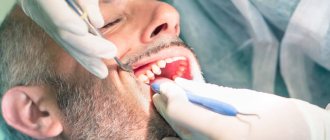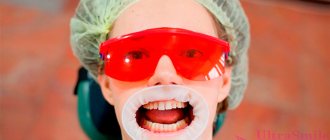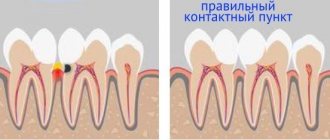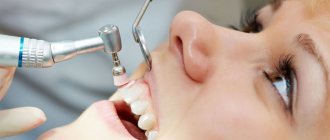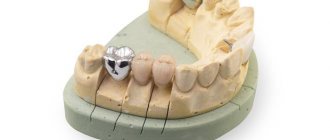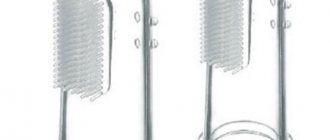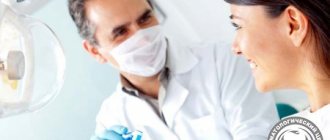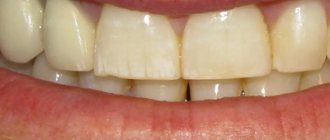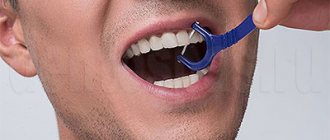Healthy teeth and a beautiful smile are not a gift from nature, they are daily care and proper protection. Daily brushing of your teeth using professional products, mouth rinses, and dental floss will help you protect your teeth from caries and other oral diseases. But, unfortunately, it is not always possible to completely clean your teeth even in the most secluded corners - this is how plaque appears on the teeth, and later tartar , which cannot be removed with a paste and brush. This will require professional teeth cleaning at the dentist's office.
To maintain the effect of the procedure and protect your teeth from various damage and diseases, you must follow a number of doctor’s recommendations, because teeth require special care after brushing. Family Dentistry Medical Center offers you a list of the most important tips:
Preventive measures
To avoid inflammatory processes in the oral cavity and relieve mild pain in the teeth, which sometimes occurs after removing tartar, you can rinse your mouth with medicinal decoctions, for example, St. John's wort, sage or even chamomile tea, which can be purchased at any pharmacy. If your teeth or gums continue to bother and hurt for a long time after hygienic cleaning, you should consult your doctor to make sure everything is okay.
Professional teeth cleaning, as well as home care, is an important and necessary procedure. By following all the doctor’s recommendations, not forgetting about the rules of hygiene, as well as regular preventive visits to the dentist and timely treatment, this is the only way you can protect your teeth from various diseases and defects. The health and beauty of your teeth depends on you, so take care of them from an early age!
Teeth hurt after ultrasonic cleaning: what to do?
Ultrasonic tartar removal is a modern way to get rid of hard deposits that cause infectious diseases of the oral cavity. This is a safe and comfortable procedure that is recommended for everyone, even pregnant women. But there is an exception to the rule - these are patients with thin damaged enamel, the ultrasound effect on which can cause pain both during and after sanitation
The fact is that tooth sensitivity may increase after ultrasonic cleaning. Therefore, before going for this procedure, you need to consult a dentist.
What is ultrasonic cleaning
Ultrasonic cleaning uses special dental equipment - an ultrasonic scaler. The principle of its operation is to generate ultrasonic waves, which, when they hit the surface of a tooth, soften plaque of varying degrees of density and remove it. In order to achieve maximum effect, the amplitude and frequency of the waves are adjusted individually for each patient. After treatment, the tooth surface becomes smooth and shiny, and also brightens by 1-2 tones.
Why can teeth hurt after ultrasonic cleaning?
If a patient’s teeth hurt after ultrasonic cleaning, this can be caused by two reasons. First of all, increased sensitivity of teeth associated with defects or damage to the enamel. Therefore, before using this service, you should strengthen your tooth enamel with fluoride-containing products and carry out a deep fluoridation procedure in a dental clinic. The second cause of pain after ultrasonic cleaning is inflammatory diseases of the oral cavity: periodontal disease, gingivitis, caries and others. Scaling may be necessary to treat these conditions. In this case, to relieve the patient from pain during the procedure, dentists use local anesthesia. The doctor will also prescribe painkillers and anti-inflammatory medications to take after ultrasonic cleaning.
What to do if your teeth hurt after ultrasonic cleaning
You can relieve pain after ultrasonic teeth cleaning at home. Applications with antimicrobial anti-inflammatory drugs (for example, Metrogil-denta, Traumeel S and others) will help relieve inflammation, relieve pain, and relieve swelling of the soft tissues of the oral cavity. If the neck of the tooth is particularly sensitive, toothpastes containing fluoride and herbal rinses should be used to care for the oral cavity. If a set of home hygiene procedures does not help relieve pain and/or it intensifies, then you need to visit a dental clinic, where specialists will select adequate treatment.
Expert opinion
Strict adherence to your dentist’s recommendations for oral care will help you avoid pain after ultrasonic tartar removal. Doctors advise brushing your teeth every time after eating on the first day after the procedure, using a soft brush and toothpaste for sensitive teeth.
It is also necessary for the first time to avoid eating cold, hot, spicy and sour foods, which have an aggressive effect on sensitive enamel.
Agree, these are quite simple and feasible medical prescriptions! If they are followed, removing tartar with ultrasound will be extremely comfortable - after all, this is the safest and most painless way to get rid of tartar used in modern dentistry.
Causes of enamel hyperesthesia
Many patients complain of increased sensitivity of teeth after tartar removal. The main reason for such complaints is the exposure of hard tooth tissues that were previously covered with tartar. The deposits partially reduced the impact of irritants - high and low temperatures, sour, sweet and spicy foods. Therefore, after the stone is removed, the enamel reacts more sharply to external factors.
Increased tooth sensitivity is caused by:
- existing diseases of the oral cavity - caries, pulpitis,
- thinning of tooth enamel in the cervical area,
- non-compliance with professional cleaning rules.
To reduce the likelihood of enamel hyperesthesia, have your teeth cleaned only by qualified dentists. Contact only experienced specialists in whose professionalism you are confident.
Types and differences of professional teeth cleaning
There are various ways to clean your mouth professionally. Each option has advantages and disadvantages. The choice of technique is made by the dentist.
Ultrasonic
It is performed using a special device - an ultrasonic scaler. The working element of the device is equipped with a nozzle that performs oscillatory movements at an ultrasound frequency of 25-50 kHz. The effect is enhanced by supplying an antiseptic solution or water through the nozzle. Deposits are removed under the influence of cavitation.
This method does not damage the enamel. When treating the oral cavity with an antiseptic, pathogenic bacteria are destroyed. The effectiveness is so high that it is possible to cope even with supra- and subgingival stones. The patient does not feel pain after brushing his teeth.
Laser
Removal of mineral deposits and plaque from the surfaces of the oral cavity is carried out under the influence of a laser beam. The liquid evaporates from them, as a result of which the destruction process begins. Peeled particles are removed with a stream of water supplied under high pressure.
The cost of the service is higher than alternative methods, due to the use of expensive equipment.
Sandblasting
Cleaning is performed using Air Flow equipment. The device even copes with old deposits. The main condition is that the coating must be soft. Air Flow does not remove tartar. The process of sanitation of the mouth involves the use of a special attachment, a mixture containing a fine abrasive, and a fixing gel. This method is used with caution in cases of increased sensitivity of the gums.
Chemical
The essence of the procedure is to apply a special gel containing hydrogen and acid to the teeth. During aging of the product, hard and soft deposits are destroyed under the influence of chemicals.
The method is painless and effective. But the interdental areas are poorly treated.
Mechanical
Sanitation is carried out using brushes and highly active pastes. This method requires more time than alternative options. But the result is high. However, in the process of mechanical impact with brushes, the risk of damage to the enamel increases. For this reason, specialists rarely resort to such cleaning.
Rehabilitation after the procedure
To prevent gum inflammation from starting after the procedure, and for the results to last for a long time, the patient is required to properly care for the oral cavity.
What is required from the patient:
- Do not consume coloring foods and drinks for the first 24 hours after the procedure. These products include: colored fruits, vegetables and berries, coffee, red wine and natural juices.
- Immediately after the procedure, do not drink too hot or cold drinks.
- Immediately after brushing, replace the old toothbrush with a new one.
- Not only use a toothbrush twice a day, but also use dental floss and irrigator at least once a day.
- Be sure to visit your dentist every six months for a routine preventive examination.
- Do not neglect professional teeth cleaning, undergo the procedure regularly according to the indications of a specialist. As a rule, doctors recommend undergoing a comprehensive cleaning twice a year.
Surgery
If the gums are severely inflamed and there are deep periodontal pockets, standard professional cleaning may not be effective. To combat inflammation in such cases, surgical treatment is indicated.
- Flap surgery - cutting off the affected areas of soft tissue, removing bacterial deposits under the gum, applying sutures.
- Open curettage is effective for periodontitis and is aimed at deep cleansing of periodontal pockets from granulations and tartar.
The doctor will determine the appropriate treatment tactics after examining the patient.
Clinical researches
Repeated clinical studies have proven that regular use of preventive toothpaste ASEPTA ACTIVE for a month can reduce bleeding gums by 60%, improve the overall condition of the oral cavity by 44% and reduce inflammation by 33%.
Sources:
- Clinical and laboratory assessment of the influence of domestic therapeutic and prophylactic toothpaste based on plant extracts on the condition of the oral cavity in patients with simple marginal gingivitis. Doctor of Medical Sciences, Professor Elovikova T.M.1, Candidate of Chemical Sciences, Associate Professor Ermishina E.Yu. 2, Doctor of Technical Sciences Associate Professor Belokonova N.A. 2 Department of Therapeutic Dentistry USMU1, Department of General Chemistry USMU2
- Study of the clinical effectiveness of treatment and prophylactic agents of the Asepta line in the treatment of inflammatory periodontal diseases (A.I. Grudyanov, I.Yu. Aleksandrovskaya, V.Yu. Korzunina) A.I. GRUDYANOV, Doctor of Medical Sciences, Prof., Head of Department I.Yu. ALEXANDROVSKAYA, Ph.D. V.Yu. KORZUNINA, asp. Department of Periodontology, Central Research Institute of Dentistry and Maxillofacial Surgery, Rosmedtekhnologii, Moscow
- Report on the determination/confirmation of the preventive properties of personal oral hygiene products “ASEPTA PLUS” Remineralization doctor-researcher A.A. Leontyev, head Department of Preventive Dentistry, Doctor of Medical Sciences, Professor S.B. Ulitovsky First St. Petersburg State Medical University named after. acad. I.P. Pavlova, Department of Preventive Dentistry
- Clinical studies of antisensitive toothpaste “Asepta Sensitive” (A.A. Leontyev, O.V. Kalinina, S.B. Ulitovsky) A.A. LEONTIEV, dentist O.V. KALININA, dentist S.B. ULITOVSKY, Doctor of Medical Sciences, Prof. Department of Therapeutic Dentistry, St. Petersburg State Medical University named after. acad. I.P. Pavlova
